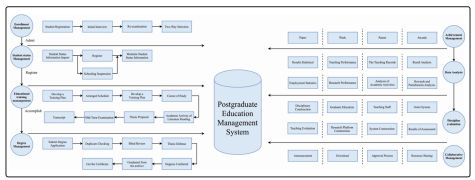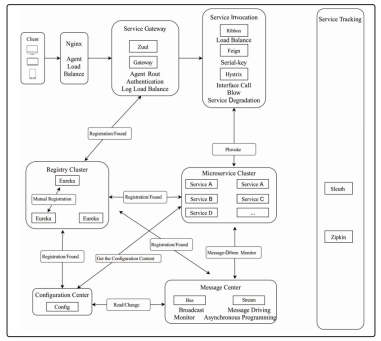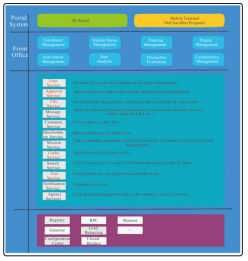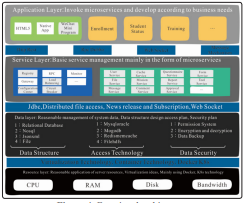Author(s): XIA Lu, YU Lei* and YANG Kun
The traditional postgraduate education management system has some limitations in its functions and mode of development. It is important to ensure that colleges and universities can remain closed without halting instruction during the pandemic prevention and control period. It is essential to solve the problem of delivering instruction and managing teachers and students at universities that offer geosciences and environmental educations of using multiple device types, both on and off campus. In this article, a new concept of postgraduate education management that can be used to cope with the new conditions is proposed, based on the characteristics of similar institutions as well as the complex functional requirements of postgraduate education management. A design for a postgraduate education management system based on the advantages of microservices architecture is discussed as well. The system helps promote the development of high-quality postgraduate educational offerings at universities with geosciences and environmental educations, optimises the soundness of postgraduate education management modes, and effectively ensures the orderly promotion of online teaching and remote management of postgraduates during the prevention and control period of pandemics, thereby promoting the refinement, understanding, and informationization of postgraduate education management systems.
China’s postgraduate education landscape has entered a phase of great development and change, and the continuous growth in enrolment and expansion in the scale of training of postgraduate students in the geosciences and environmental sciences has posed a great challenge to the management of postgraduate education [1]. During the pandemic, the problems that already existed, such as postgraduate students’ inability to select courses in off-site locations, instructors’ unfamiliarity with online lectures, and the communication barriers between the administrators, faculty and students were highlighted. It is important to ensure that schools are closed without halting classes during the pandemic prevention and control period and to facilitate teachers’ and students’ ability to teach and manage information through multiple channels such as computers, iPads, and mobile phones, while working on and off campus [2]. With the development of artificial intelligence, cloud computing, big data, Internet+, and other technologies, the use of emerging information technologies to facilitate the management of postgraduate education is about to make a historic leap, and the information construction of postgraduate education will become the focus of the reforms made to postgraduate education management [3,4]. The construction of a safe, stable, and scientific postgraduate education management system for universities with geosciences and environmental education is an important to ensure standardised, systematic, scientific, and refined management as well as intelligent information management in the postgraduate education context.
At present, the informatization of postgraduate education management has transitioned from the traditional digital campus stage based on the application and integration of platforms to the smart campus stage of ‘;Internet+’ and ‘;Smart+’[5]. It has been difficult to adapt traditional software architecture to cope with the rapid changes in user needs that have occurred in the Internet era, and microservice architecture (MSA) has gradually been mainstreamed to meet these changes [6]. Microservices are based on componentisation and loose coupling, that is, service- oriented interface encapsulation, lightweight communication interaction, and fine-grained module division. Microservices have the following two main advantages: (1) modules have strong autonomy, enabling them to easily meet the needs of online applications in terms of rapid changes and independent module updates; and (2) modules have good scalability, enabling them to easily meet the needs of online applications, unpredictable users, and dynamic resource allocation [7]. Therefore, microservices are gradually becoming the basis of the dominant architectural model for building online applications [8].
In this paper, a postgraduate education management system based on MSA is discussed to provide open, integrated, and unified intelligent information services for teachers and students at universities with geosciences and environmental education, constituting a new direction for the development of information services at today’s universities.
The traditional postgraduate education management system has some limitations both in terms of its functions and development mode [9]. According to investigation, a postgraduate education management system requires the following in the process of information transformation: (1) The system must have complex user management capabilities and diverse use rights. Those involved in the system include administrators, postgraduate instructors, various types of managers at all levels, and postgraduate students. Various roles involve unused use rights; and the huge quantity of users requires the system to be reasonably designed. (2) The system must have a wide range of content and include a large amount of data. A postgraduate education management system is used not only as a platform for postgraduate education and learning; it can also be an interactive channel for postgraduate education management and a database containing various types of management data and a large amount of information about postgraduates including their date of enrolment, educational development, and date of graduation. The broad nature of the information included in such a system imposes strict requirements regarding data-management issues and the security of the database. (3) The system must be capable of accommodating multiple scenarios, multiple use modes for device types, and multiple geographical peculiarities and forms of device use. Teachers and students at universities with geosciences and environmental education study plateaus and oceans intensively, which necessitates strict requirements for the postgraduate education management, thus it is especially important to ensure that those concerned can use the system safely in the field when working with computers, mobile phones, and other multi-channel devices.
Postgraduate education management mainly includes the following parts: (1) enrolment management; (2) student status management; (3) educational training management; (4) degree management; (5) achievement management; (6) data analysis; (7) discipline evaluation; and (8) collaborative management. Presently, some commercial platforms include some of the above-mentioned functions, but the postgraduate education management systems used at colleges and universities offering geosciences courses differ from others and are subject to stricter requirements regarding their integrity, standardisation, security, stability, and fairness. In this article, we independently design a business process for postgraduate education management systems used at universities with geosciences and environmental education. Figure 1 shows the flow chart of such a system.

Figure 1: The flow chart of postgraduate education management system According to the business flow chart of the system, the postgraduate education management system of such universities differs from other postgraduate education management systems in important ways, which are mainly reflected in the following four modules. The first concerns the training management module. This module mainly includes user management, authority maintenance, course management, student information management, and teacher information management. Postgraduates can make plans for their development and online curricula through many devices, such as computers and mobile phones, both on and off campus. There are many field-oriented practice tasks for postgraduates at such universities. This module not only allows postgraduate students to complete online courses through various devices in various scenarios; it also allows instructors to teach online through multiple devices in various scenarios. Knowledge transfer is not limited to textbooks at universities with geosciences and environmental education, as such courses typically require a lot of practical field knowledge and a great commitment to the conservation of mountains and rivers. During a pandemic, instructors can use such systems to teach in the field using a variety of devices, such as computers, iPads, and mobile phones.
The degree management module includes sending notifications, chatting, sending and receiving documents, approving materials, engaging in online argumentation, participating in video classrooms, raising one’s hand to speak, recording real- time videos, and presenting statistics. Those involved in online argumentation mainly include members of the defence committee, degree applicants, spectators, and administrators. Various roles are assigned to these people, with each having specific user rights. Those assigned various roles are connected to the same classroom environment, with each having similar functions and different user rights. Postgraduates complete the requirements of their training plans, submit relevant supporting documents through the system, and submit their degree applications. This module involves the presentation of a postgraduate thesis, which requires a lot of data interaction and secure data transmission.
The module concerned with results management includes management of the security of postgraduate research results. Postgraduates’ scientific research at universities with geosciences and environmental education cover a large number of topics within the scope of national security regulations: geological minerals, metallurgical industries, petroleum, water conservation, environmental protection, marine environments, material industries, and various types of confidential documents and data. The storage, transmission, and interactions between such data require safe, reliable network systems.
The collaborative management module includes leaves of absence for postgraduate students, approval by instructors, and the issuance of notifications by managers. The characteristics of field work at universities with geosciences and environmental education require the use of a convenient, reliable system for management. Postgraduate students can submit management-related applications online using various devices in various geographical areas and may even work at sites like mountains, deserts, and oceans; likewise, supervisors can use various devices in various geographical areas to grant their approval. Interactions between administrators and students should not be limited by the available devices or geography.
Through comprehensive consideration of the specific features of the possible software architecture solutions combined with the system requirements of such universities, we chose the front- and back-end separation architecture within the popular Spring Boot framework and the Vue framework to improve the efficiency of the system’s development [10]. The system was layered with the help of MVC design and primarily included a business logic layer, view layer, data persistence layer, and control layer. The system was based on the Spring Boot framework to save time in configuring XML files, referring to annotations, quickly building an environment, and enabling the use of the front-end site style provided by the Vue framework based on its own needs for improving the construction of the view layer. The front-end page used AJAX requests to pass the data to the control layer for parsing, and then the data entered the business logic layer for processing. The business logic layer used the mapping and interface of the data persistence layer to operate the database, and, finally, the front-end page received the returned results to complete the front- and back-end data interaction. Figure 2 shows the functional microservice relationships of the system. Within the architecture, the service gateway is an entry point for providing services to the outside world in a unified manner; the business layer, in which the business requirements are implemented, interacts with the data layer through Feign and is overloaded with Hystrix for overload protection and Ribbon for load balancing; the data layer functions as a data service to the outside world through HTTP; the core basis of Zuul is a series of filters performing a series of operations in the HTTP request and response process. All client requests pass through the Zuul Servlet to the ZuulFilter Runner and are then assigned to the three filters. Eureka aids in service discovery and management. The service gateway functions as the entry point and unifies the services to the outside world. Nginx functions as a proxy and can be load-balanced across various gateway instances.

Figure 2: Microservice function diagram
A postgraduate education management system at universities with geosciences and environmental education was designed using a multi-tiered architecture, as shown in Figure 3.

Figure 3: Technology layer diagram
This layer represents the services provided by the business in a specific area of the platform. On the platform, there are systems for admissions, registrations, training, and submitting dissertations. Various systems provide services in specific business areas.
This layer can be divided into basic, public, and support services. The gateway is responsible for handling HTTP requests and responding to them in HTML or JSON / XML (for the Web Services API). It also provides Rest API for each client and has authentication, security, loading, caching, filtering, and flow- limiting responsibilities. This layer is built on Spring Cloud and consists of several small autonomous services that work together. The platform determines service boundaries based on business boundaries, and each service is focused only on the area within its own boundaries.
This layer provides data support services for the upper-layer services and uses various storage technologies and data-security methods to support specific data structures. The main categories include the following: Redis cluster, which provides caching services for the upper layer with high responsiveness and in- memory operations; Mongodb cluster, because Mongodb has a flexible document model, high-availability replica sets, scalable sharding clusters, and other features, and can provide storage services for the layer on top of it, such as linked logs. Mongodb clusters use a replication + sharding architecture to address availability and scalability issues; MySQL or Oracle clusters which store data with transactional requirements; and Resource layer, which provides the server with a hardware environment and bandwidth as well as other types of support required for the operation of various applications in the upper layer.
Figure 4 shows the functional architecture of the system. Microservices embody decentralisation and natural distribution are the ‘;middle office’ strategy used to realise the specific implementation of IT systems’ technical architecture; they are also used to solve the challenges of system resilience scalability, agile iteration, and technology-driven business innovation when a business is growing and innovating rapidly [11]. Middle office architecture, simply put, involves the reuse of capabilities, its own kind of methodology, and governance ideas [12]. Microservices, which are small business units that can be developed, maintained, and deployed independently, constitute a technical architecture approach. The ‘;front office’ emphasises innovation and flexibility, while the ‘;middle office’ emphasises the construction of core infrastructure capabilities, which appear in the form of microservices to support rapid iteration and innovation in various scenarios on the business side, enhancing managers’ ability to plan and control and coordinate initiatives.

Figure 4: Functional architecture
The core feature of MSA is the horizontal splitting of services. ‘;Service splitting’ is based on a complete business system decoupled into services, which involve individual responsibilities, with no coupling between them, and which can be developed and maintained independently. In addition, the front-end UI framework, load balancing of microservice containers, existence of service registries, and existence of APIs involve many key technical features.
The key steps in the development of microservices are as follows: Step (1): Build a configuration server using Spring Cloud Config, enable Spring Cloud Config functionality for the application, and enable the functioning of the embedded configuration server during application bootstrapping using @EnableConfigServer annotation. Step (2): Enable service discovery using Eureka. All other applications (including the discovery service) require the addition of the spring-cloud-starter-config dependency to enable the configuration client. The embedded discovery server should then be set to run during application booting by placing an annotation on the main class via @EnableEurekaServer. Step (3): Establish microservices with Spring Boot and Spring Cloud. By adding the @EnableDicoveryClient annotation, microservices can be automatically added to the registry at inception. Step (4): Build the API gateway. Step (5): Configure the front-end pages and use the Vue framework to bind the business data model to page variables to provide users with web page access. Step (6): Test, deploy, and run the microservices application.
Corresponding to the eight microservices in the application microservice layer, the system has eight major functions: enrolment management, discipline assessment, student status management, course management, collaboration management, reward and punishment management, degree management, results management, and data analysis. Modular design is a mature software design approach used to reduce system coupling and improve cohesion [13].
The enrolment management module concerns the functions of student registration, preliminary examinations, review examinations, and two-way selection of postgraduate students and instructors in the admissions stage.
The academic registration management module is related to the management of the postgraduate students’ academic information, including management of new students’ registration and the work related to transfers of supervisors, changes of majors, early graduations, leaves of absence, and suspensions of study during the academic year.
The training management module contains sub-modules for training programme development, class scheduling systems, training plan development, distance learning, course management, thesis proposal, mid-term assessments, and grade management. It includes the functions of training programme releases, training plan formulation, course creation and scheduling, and class transfers. The thesis proposal and mid-term assessment sub-module is concerned with the application and assessment of the relevant parts of the training process. The grade management module is responsible for the realisation of functions such as course assignment releases, exam releases, uploading of attachments, assignment reviews, and grade releases. Finally, the degree management module enables postgraduate degree application submissions, online argumentation, thesis-checking services, blind thesis reviews, and thesis-archiving services.
In this article, the limitations of traditional postgraduate education management systems were analysed in terms of their functions and mode of development, and the defects of the traditional postgraduate education management modes were summarised. The requirements of postgraduate education management systems within the new context were investigated based on the following requirements: the system must accommodate numerous users with complex roles; the system must accommodate many types of content; the system must accommodate multiple scenarios and multiple use modes of multiple device types; and the system’s functions must be designed and constructed in a personalised manner. Using the advantages stemming from the loose coupling and componentisation of the MSA, we proposed a solution for postgraduate education management systems used at colleges and universities with geosciences and environmental education based on the MSA with the aim of building a new model for postgraduate education management. Our solution can ensure smooth postgraduate education management at universities with geosciences and environmental education during the prevention and control period of a pandemic and be used to promote the systematic, standardised, information-driven, and intelligent development of postgraduate education management systems. It is also cost-effective and intelligently designed, which enhances its practical value.
This study was financially supported by China University of Geosciences (Beijing) Graduate Education Reform Project (Grant Nos YJG202004).
